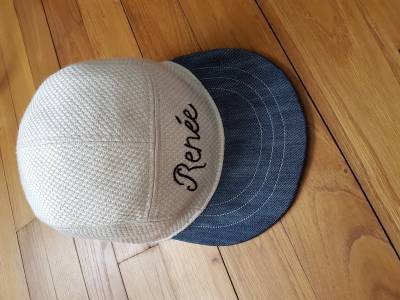Camille Mansuy. Giving a new life to discarded textiles
By Hilda Zara
Camille Mansuy is currently developing a project in the field of fashion and clothing with strong ethical and ecological values: a hand-made cap locally produced and made from discarded textiles named Renée la casquette upcyclée. In order to have support in the project definition and development process, Camille participated in the AYCH local support programme in Brest, France from April to June 2019.
Keywords: green clothing, local and socially responsible economy, self-expression, mixed fashion codes
From the idea of an object to developing a circular system
For Camille, the idea of developing a cap emerged from a realization: although as a fashion piece caps could be considered gender neutral, it seems that high street shops target young males as their main consumers. And if we made caps that could be used by anyone who wants to? This questioning was the starting process of a thorough research process that has allowed Camille to push her idea much further.
From understanding the importance of a cap as means for self- expression, the cultural value of the cap as a streetwear piece and icon of the hip-hop culture to its particular technical aspects, Camille delved into the rich meanings and know-how embedded in a 5 panels cap. However, it is a fast fashion industry issue that caught her attention and became a critical aspect of her project. The increasing amounts of clothing that are wasted worldwide: one garbage truck of clothes is burned or sent to landfills every second. The average consumer bought 60 per cent more clothes in 2014 than in 2000 but kept each garment for half as long (Ellen MacArthur Foundation, 2017).
As a way to addressing the clothing waste issue at a local scale, the cap developed by Camille is made from discarded textiles. Finding second-hand textile providers, collecting, assorting and treating the textiles in order to assemble the caps are key dimensions of the cap’s circular production system. The idea is to integrate into the system local charity associations that can sell to Camille textiles gathered through their network. In this sense, the project would also indirectly benefit already existing workforce reintegration programmes.
Prototyping at the core of the process
Throughout the AYCH local support programme in Brest, Camille used prototyping as a way of better defining particular aspects of her project. With the help of a local tailor, she has created different prototypes in order to test various materials, shapes and joining systems.
However, prototyping not only has facilitated the evolution of the initial idea from technical, functional and aesthetical perspectives; but it has also been a powerful tool to identify key communication strengths of the project. During the AYCH programme, a very important part of the process was to recreate “scenarios” in which the project holder had to put herself in the situation of having to present the project to different stakeholders. This process of getting the project out to the real world (prototyping) through different methods (scenarios, physical prototypes) is still key for making quick progress in the creative process.
The AYCH programme as a booster
Developing a project out of an idea can be complex and hard work. During the AYCH programme in Breast managed Camille managed to reflect upon different aspects of her project with an approach and with tools that simplified the task and accelerated the process in unexpected ways.
One key strategy was to put the participant’s personal projects at the heart of every theoretical notion explored, no matter how difficult and abstract the notion was. Another very important feature of the programme was its capacity to assess the project within a local ecosystem. Identifying key local stakeholders (funders, textile providers, technical experts, etc) was possible through this exercise. For instance, the tailor, who proved to be essential for defining and developing the project was identified and contacted thanks to the AYCH programme. Finally, thanks to the programme it was possible to put the project into perspective regarding key larger environmental and societal issues. That is how the green clothing and local economy approaches took an even more important place in the project definition.
Looking Forward
Although Camille has already produced a batch of caps that could already be commercialised, there are still some challenges to face for accomplishing the project. The legal status of Camille and her project remains one of the main challenges for the project before commercialization. Although Camille is engaged in almost every step of the production process (collecting textiles, cleaning, cutting), for the moment the production capacity is limited since there is only one tailor to sew the pieces together. Finally, Camille hopes to develop a line of other accessories made under the same principles.
References
Ellen MacArthur Foundation, A new textiles economy: Redesigning fashion’s future, 2017, http://www.ellenmacarthurfoundation.org/publications)
Useful Links
Camille's brand “Renée Casquettes” https://www.facebook.com/Reneecasquettes/
Conversation with Camille Mansuy https://www.aych.eu/questions-camille-mansuy/





